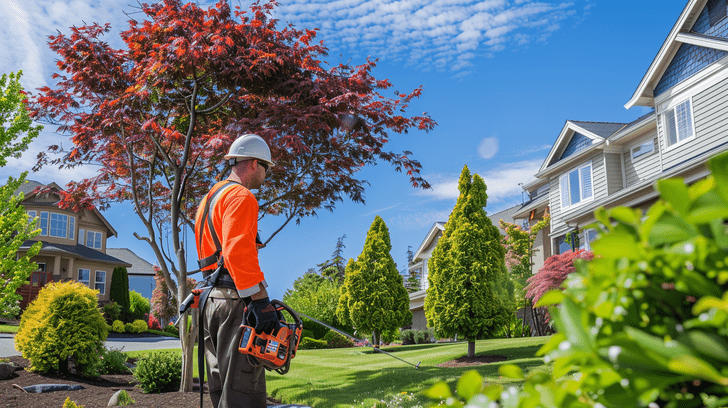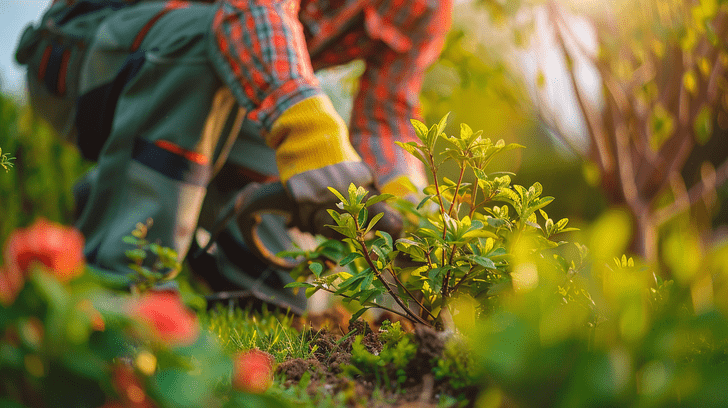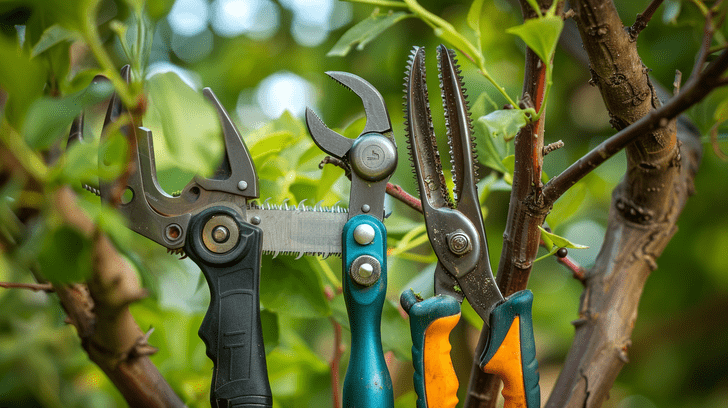Best Time For Tree Trimming: When To Prune Trees
When deciding the ideal time for tree trimming, consider the specific needs of the tree to maintain its health and vigor.
Winter pruning sets the stage for robust spring growth, while spring pruning is crucial for peak health and shaping. Summer trimming focuses on airflow and fruit production.
For flowering trees, follow specialized techniques based on species and timing. Proper care of young trees guarantees a strong framework and balanced growth.
Avoid pruning mistakes like overdoing it and cutting incorrectly. Remember, precise timing is key to nurturing your trees effectively.
Importance of Tree Trimming
When it comes to tree trimming, understanding the importance of proper pruning techniques is essential. Factors such as tree species, seasonal considerations, and the desired outcome all play a role in determining the best time for trimming.
Importance of Proper Tree Pruning
Proper tree pruning is a vital practice that guarantees the health and longevity of your trees. When it comes to tree care, understanding the importance of proper pruning techniques is essential.
Tree pruning not only enhances the aesthetic appeal of your trees but also plays a significant role in maintaining their overall well-being.
By engaging in proper pruning practices, you can promote healthy growth, prevent disease, and maintain structural integrity.
It’s essential to remember that the best time to trim your trees can vary depending on the species and specific needs of the tree.
Consulting with a professional arborist can help determine the most suitable timing for tree trimming and pruning, maximizing the benefits for your trees.
Factors Influencing Pruning Times
To determine the best timing for tree trimming, it’s important to take into account various factors that influence pruning times. Consider the following:
- Tree Species: Different tree species have varying ideal times for pruning to promote their health and growth.
- Overall Growth: Understanding the overall growth patterns of the tree is essential in determining when to prune for maximum effectiveness.
- Health of the Tree: The current health status of the tree plays a significant role in deciding the appropriate time for pruning activities.
- Seasonal Considerations: Factors such as weather conditions and the time of year can impact the success of tree pruning efforts.
Best Time to Prune Trees by Season
When considering the best time to prune trees by season, it’s essential to understand the specific characteristics and requirements of each season.
Winter pruning, for example, is ideal for shaping and reducing the size of trees while they’re dormant.
Spring pruning focuses on removing dead or damaged branches and promoting new growth.
Summer pruning is often done for corrective purposes, and fall pruning is important for preparing trees for the winter months.
Winter Pruning
During the winter months, trees undergo dormancy, making it an optimal time for precise pruning to promote healthy growth and structure.
Winter pruning is an essential technique that can benefit the overall health of your trees. Here are four key points to keep in mind:
- Promotes Growth: Trimming during late winter encourages robust growth when spring arrives.
- Prevents Disease Spread: Removing dead or diseased branches in late fall or early winter helps prevent diseases from spreading.
- Enhances Structure: Pruning in winter allows for better visibility of the tree’s structure, enabling more accurate cuts.
- Stimulates Healing: Trees heal faster from cuts made during dormancy, minimizing stress and maximizing recovery.
Winter pruning sets the stage for healthy spring growth and overall tree vitality.
Spring Pruning
As you shift from winter pruning to spring pruning, the timing becomes essential in ensuring peak tree health and growth. Spring pruning is best done just before the tree enters its rapid growth phase, allowing wounds to heal quickly.
The best time to prune a tree in spring is when it’s still dormant but has just begun to show signs of new growth. For flowering trees, it’s important to prune right after they bloom to avoid cutting off next year’s flowers.
Proper spring pruning can help shape the tree, promote strong branch structure, and encourage abundant flowering. Timing is key when it comes to spring pruning to maximize the benefits for your trees.
Summer Pruning
Summer pruning optimizes tree health and growth during the peak of the growing season. To guarantee your trees thrive in the summer months, follow these expert tips:
- Timing is Key: Schedule summer pruning sessions from late spring to early summer to avoid interfering with the tree’s natural growth cycle.
- Focus on Deadwood: Remove any dead or damaged branches to promote new growth and prevent diseases from spreading.
- Thinning Out: Thin out dense areas of the canopy to improve airflow and sunlight penetration, aiding in photosynthesis.
- Promote Fruit Production: Prune fruit trees in the summer to shape their growth, enhance fruit quality, and encourage new fruiting wood for the next season.
Fall Pruning
For ideal tree health and growth as the seasons change, fall pruning is essential to maintain the structural integrity and vitality of your trees.
Fall pruning, often considered the best time to trim trees, allows for the removal of dead or diseased branches before winter sets in. It’s advisable to conduct pruning in late fall when trees are dormant, reducing stress and minimizing sap loss.
Maple trees, in particular, benefit greatly from fall pruning as it helps enhance their overall health and appearance. By strategically trimming branches during this season, you promote new growth in the spring and prevent potential hazards caused by weak or overgrown limbs.
Embrace fall pruning as an important step in caring for your trees year-round.
Special Considerations for Tree Types
When contemplating tree types for trimming, it’s essential to understand the unique characteristics of each category.
Deciduous trees, evergreen trees, fruit trees, and flowering trees each have specific requirements for best pruning.
Deciduous Trees
Consider the specific characteristics of deciduous trees when planning tree trimming to promote the best health and growth.
Deciduous trees shed their leaves annually, making them unique in their pruning requirements. Here are essential points to keep in mind:
- Best Time to Prune Trees: Ideal pruning time for deciduous trees is in late winter or early spring.
- Year to Prune Trees: Aim to prune deciduous trees annually to maintain their shape and encourage new growth.
- General Rule: Remove dead or diseased branches first, followed by shaping cuts to enhance the tree’s structure.
- Trees in the Fall: Avoid pruning deciduous trees in the fall, as it can lead to excessive sap bleeding and make them susceptible to diseases.
Evergreen Trees
When trimming evergreen trees, pay specific attention to the unique characteristics of each tree type to promote healthy growth.
Evergreen trees have different trimming needs compared to deciduous trees. Proper trimming is essential for maintaining the health and appearance of evergreens.
When making pruning cuts on evergreen trees, it’s important to avoid cutting directly through the branch collar, which is the swollen area at the base of the branch where it meets the trunk.
Cutting into the branch collar can impede the tree’s natural healing process and lead to disease or decay.
Understanding the specific requirements of different types of evergreen trees will ensure that your pruning efforts contribute to the overall well-being of the tree.
Fruit Trees
For maximum fruit tree trimming results, meticulous attention to the distinct characteristics of each tree variety is important to guarantee strong growth and bountiful harvests.
When it comes to fruit trees, proper pruning techniques can have a major impact on their health and productivity.
Here are some essential tips to help you trim your fruit trees better:
- Understand Tree Varieties: Different fruit trees require specific pruning methods based on their growth habits.
- Timing Matters: Prune fruit trees during their dormant season to promote new growth without causing stress.
- Remove Deadwood: Eliminate dead or diseased branches to enhance overall tree vitality.
- Balance Growth: Aim to maintain a balanced canopy to ensure sunlight penetration and adequate air circulation.
Flowering Trees
Understanding the distinct characteristics of flowering tree types is essential for implementing specialized pruning techniques that promote ideal growth and blooming.
When considering the best time of the year to trim flowering trees, it’s vital to focus on the specific species.
Trees that bloom early in the spring, such as cherry blossoms and magnolias, benefit from pruning right after flowering to encourage new growth for the following year.
On the other hand, crape myrtles should be pruned in late winter to early spring to stimulate abundant summer blooms.
Timing is key when it comes to enhancing the beauty of flowering trees through pruning.
Pruning Young and Newly Planted Trees

When tending to young trees, it’s vital to establish a strong framework by selectively pruning to encourage proper growth and structure.
Proper care for newly planted trees involves strategic pruning to promote root development and establish a balanced canopy.
Understanding the specific needs of young and newly planted trees is essential for fostering healthy growth and longevity.
Guidelines for Young Trees
To guarantee proper growth and development, young trees should be pruned according to specific guidelines for best health and structure.
When it comes to pruning your trees, especially young ones, following these precise steps is essential:
- Start Early: Begin pruning young trees in their formative years to shape their growth properly.
- Focus on Deadwood: Remove any dead or diseased branches to promote overall tree health.
- Mind the Ratio: Maintain a balance between removing lower branches for clearance and retaining enough foliage for photosynthesis.
- Avoid Over-Pruning: Only remove what’s necessary to avoid stunting the tree’s growth potential.
Care for Newly Planted Trees
For best growth and resilience in newly planted trees, precise pruning techniques are essential to establish a strong foundation.
When caring for newly planted trees, it is important to follow best practices to guarantee the health of the tree and promote new growth.
Unlike mature trees, newly planted trees require specific attention during the growing season to encourage proper development.
Proper pruning not only shapes the tree but also helps in the establishment of a strong root system.
| Pruning Aspect | Description | Importance |
| Timing | During the growing season for optimal results | Promotes new growth |
| Technique | Precision cuts to remove damaged or weak branches | Ensures tree health |
| Frequency | Regular monitoring and light pruning as needed | Establishes tree shape |
Common Pruning Mistakes to Avoid
Avoid the common pruning mistakes that can jeopardize the health and growth of your trees by following these expert guidelines.
When engaging in tree trimming during fall, winter, or early spring, be mindful of the following:
- Improper Pruning Cuts: Make clean cuts close to the branch collar without leaving stubs.
- Over-Pruning: Avoid removing more than 25% of the tree’s canopy in a single season.
- Pruning at the Wrong Time: Refrain from pruning during the tree’s active growth periods.
- Ignoring Tree Health Signs: Look out for decay, cracks, or signs of disease before pruning.
Year-Round Tree Care Tips
Maintain peak tree health throughout the year by implementing strategic care practices tailored to each season’s specific requirements.
Certified arborists or tree surgeons emphasize the importance of timing when it comes to tree care.
Different kinds of trees may need specific attention at different times of the year to guarantee excellent growth and health.
Routine pruning is essential for tree maintenance, but the timing of this task can vary depending on the species.
Consulting with professionals like certified arborists can provide valuable insights into the best practices based on the time of the year and the specific needs of your trees.
By following expert advice and understanding the seasonal demands of your trees, you can promote their well-being and longevity effectively.
FAQ
What month is best to trim trees?
To achieve the best results when trimming trees, consider the ideal month for this task.
Tree trimming is most beneficial when done in early winter, typically between late November and early February. Here are some key reasons why this timing is important:
- Prevent Oak Wilt: Trimming oaks during the dormant season reduces the risk of spreading oak wilt.
- Spot Diseased Branches: It’s easier for a certified arborist to identify and remove diseased branches in the winter.
- Promote Tree Health: Pruning during this period can help your tree thrive in the upcoming growing season.
- Avoid Stress: Trees are dormant in winter, minimizing stress caused by pruning activities.
Is there a wrong time to trim trees?
Timing is important when it comes to trimming trees to promote excellent health and growth.
While it’s essential to prune trees at the right time, there are also incorrect times to trim them.
The general rule is to avoid trimming trees in the late summer or early fall. During this period, trees are preparing for dormancy, and pruning can stimulate new growth that may not have enough time to harden off before winter, making them vulnerable to cold damage.
Additionally, pruning during the winter months can lead to slow healing of wounds from pruning due to the tree’s dormant state.
If in doubt, consult with arborists or your local cooperative extension service for guidance on the best time to trim a tree to ensure its health and strength.
Is it okay to trim trees in the summer?
During the summer months, pruning trees can be crucial, but it’s important to take into account specific factors to guarantee the health and vigor of the tree.
When considering tree trimming in the summer, remember the following:
- Timing: Choose early or late summer for tree trimming to minimize stress on the tree.
- Hydration: Make sure trees are adequately watered before and after pruning to aid in recovery.
- Disease Prevention: Trim in summer to prevent diseases that are more prevalent during this season.
- Selective Pruning: Focus on dead or damaged branches to enhance tree health without excessive stress.
Summer tree trimming can benefit tree health if done thoughtfully, contributing to overall year-round tree care.
Is it better to prune trees in spring or fall?
Pruning trees in either spring or fall can greatly impact their overall health and growth potential. The best time to prune trees depends on various factors.
In spring, trees are actively growing, making it an optimal time for pruning because they can quickly heal and recover from any cuts. This period also allows for better visibility of the tree’s structure without foliage obstructing the view.
On the other hand, fall pruning can help promote root growth during the dormant winter months. It’s important to avoid pruning in late summer as it can stress the tree before winter dormancy.
Ultimately, the decision to prune in spring or fall should be based on the specific needs and characteristics of the tree.
Conclusion
In summary, keep in mind that the optimal time for tree trimming is essential for the health and growth of your trees.
By following the seasonal guidelines, considering the specific needs of each tree type, and avoiding common pruning mistakes, you can guarantee the longevity of your trees.
Remember, a stitch in time saves nine, so don’t delay in giving your trees the care they need to thrive year-round.
Happy trimming!







